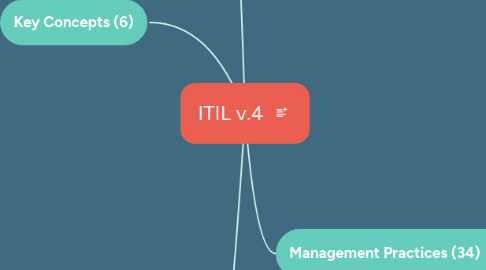
1. Dimensions (4)
1.1. Organizations & People
1.1.1. Roles. Responsibilities
1.2. Information & Technology
1.3. Partners & Suppliers
1.3.1. Goods Supply
1.3.2. Service Delivery
1.3.3. Service Partnership
1.4. Value Streams & Processes
1.5. External Factors (6)
1.5.1. Political factors
1.5.2. Economical factors
1.5.3. Social factors
1.5.4. Technological factors
1.5.5. Legal factors
1.5.6. Environmental factors
2. Key Concepts (6)
2.1. 1. Value and Value Cocreation
2.2. 2. Organization and Stakeholders
2.2.1. Service Provider
2.2.2. Consumer
2.3. 3. Services and Products
2.3.1. Service
2.3.2. Product
2.4. 4. Service Offerings
2.4.1. Goods
2.4.2. Access to Resources
2.4.3. Service Action
2.5. 5. Service Relationships
2.5.1. Service Provision
2.5.2. Service Consumption
2.5.3. Service Consumption
2.5.4. Service Relationship Model
2.6. 6. Value Outcomes
2.6.1. Costs
2.6.2. Risks
2.6.3. Utility & Warranty
3. ITIL Service Value System (SVS)
3.1. Opportunity, Demand, Value
3.2. Guiding Principles (7)
3.2.1. 1. Focus on Value
3.2.2. 2. Start Where you Are
3.2.3. 3. Progress iteratively with feedback
3.2.4. 4. Collaborate and promote visibility
3.2.5. 5. Think and work holistically
3.2.6. 6. Keep it simple and practical
3.2.7. 7. Optimize and automate
3.3. Governance
3.3.1. Evolve, Direct, Monitor
3.3.2. Accountable for org's performance and compliance
3.4. Service Value Chain Activities (6)
3.4.1. 1. Plan
3.4.2. 2. Improve
3.4.3. 3. Engage
3.4.4. 4. Design and Transition
3.4.5. 5. Obtain
3.4.6. 6. Deliver and Support
3.5. Continual Improvement
3.5.1. Where are we now?
3.5.2. Where do we want to be?
3.5.3. How do we get there?
3.5.4. Take Action
3.5.5. Did we get there?
3.5.6. How do we keep the momentum going?
3.6. Continual Practices
4. Management Practices (34)
4.1. General Management Practices (14)
4.1.1. 1. Architecture Management
4.1.2. 2. Continual Improvement
4.1.3. 3. Information Security Management
4.1.4. 4. Knowledge Management
4.1.5. 5. Measurement & Reporting
4.1.6. 6. Organizational Change Management
4.1.7. 7. Portfolio Management
4.1.8. 8. Project Management
4.1.9. 9. Relationship Management
4.1.10. 10. Risk Management
4.1.11. 11. Service Financial Management
4.1.12. 12. Strategy Management
4.1.13. 13. Supplier Management
4.1.14. 14. Workforce & Talent Management
4.2. Service Management Practices (17)
4.2.1. 1. Availability Management
4.2.2. 2. Business Analysis
4.2.3. 3. Capacity & Performance Management
4.2.4. 4. Change Enablement
4.2.5. 5. Incident Management
4.2.6. 6. IT Asset Management
4.2.7. 7. Monitoring & Event Management
4.2.8. 8. Problem Management
4.2.9. 9. Release Management
4.2.10. 10. Service Catalogue Management
4.2.11. 11. Service Configuration Management
4.2.12. 12. Service Continuity Management
4.2.13. 13. Service Design
4.2.14. 14. Service Desk
4.2.15. 15. Service Level Management
4.2.16. 16. Service Request Management
4.2.17. 17. Service Validation & Testing
4.3. Technical Management Practices (3)
4.3.1. 1. Deployment Management
4.3.2. 2. Infrastructure & Platform Management
4.3.3. 3. Software Development & Management
